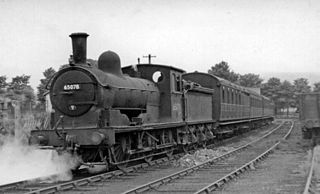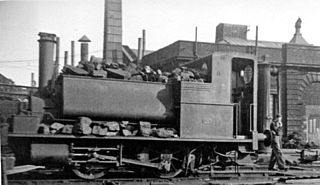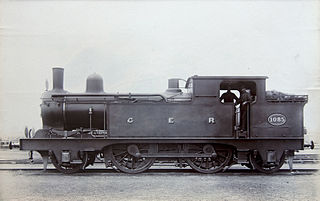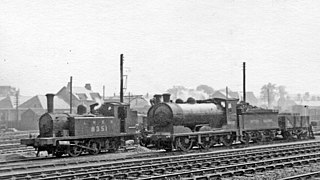Related Research Articles
Sir Vincent Litchfield Raven, KBE was an English railway engineer, and was chief mechanical engineer of the North Eastern Railway from 1910 to 1922.
The London and North Eastern Railway (LNER) produced several classes of locomotive, mostly to the designs of Nigel Gresley, characterised by a three-cylinder layout with a parallel boiler and round-topped firebox. It produced the most famous locomotive of its day, 4468 'Mallard', the holder of the world steam locomotive speed record. It also built the world-famous 4472 'Flying Scotsman'. However, its locomotive inheritance was much greater than just the 'A4 Class', it also produced highly successful mixed-traffic and freight designs.

Sentinel Waggon Works Ltd was a British company based in Shrewsbury, Shropshire that made steam-powered lorries, railway locomotives, and later, diesel engined lorries, buses and locomotives.
LNER Class A4 No. 4469 Sir Ralph Wedgwood was an A4 class locomotive of the LNER. Built at Doncaster Works, it was originally named Gadwall, being renamed Sir Ralph Wedgwood in March 1939 in recognition of Wedgwood's sixteen years of service as Chief Officer of the LNER between 1923 and 1939.

The North Eastern Railway (NER) Class C1, was a class of 0-6-0 freight locomotives designed by T.W. Worsdell. They were used throughout the NER system, although particularly in Teesside between 1886 and 1962.

The North Eastern Railway Class T2, classified as Class Q6 by the LNER, is a class of 0-8-0 steam locomotive designed for heavy freight, especially for hauling long coal trains to various collieries in the North Eastern region of the UK, with a maximum speed of 40 miles per hour. 120 were built at Darlington Works and Armstrong Whitworth between 1913 and 1921 to the design of Vincent Raven, based on the NER Class T and T1. The batch of fifty built by Armstrong Whitworth from 1919 were A-W's first locomotives to be built, after the conversion of their Scotswood works from ordnance to peacetime production.

The North Eastern Railway Class S3, classified B16 by the LNER, was a class of 4-6-0 steam locomotive designed for mixed traffic work. It was designed by Vincent Raven and introduced in 1920. The earlier members of this class were fitted with Westinghouse Brakes - all of this equipment was removed during the 1930s.
A number of different numbering and classification schemes were used for the locomotives owned by the London and North Eastern Railway (LNER) and its constituent companies. This page explains the principal systems that were used. The following abbreviations for the constituent companies are used on this page:

Gateshead TMD was a railway traction maintenance depot situated in Gateshead, England. The depot code was 52A during the steam era and GD later on.

The North Eastern Railway (NER) Class H, classified as Class Y7 by the London and North Eastern Railway (LNER) is a class of 0-4-0T steam locomotives designed for shunting.

The GER Class T26 was a class of 2-4-0 steam tender locomotives designed by James Holden for the Great Eastern Railway. At the 1923 grouping they passed to the London and North Eastern Railway, who classified them E4. Eighteen survived into British Railways ownership in 1948, and the last was withdrawn in 1959, making them the last 2-4-0 tender locomotives at work in Britain. Their BR numbers were 62780–62797.

The GER Class 209 was a class of 0-4-0 saddle tank steam locomotives of the Great Eastern Railway. These locomotives were similar to the NBR G Class but had flat-topped, instead of round-topped, tanks. A total of eight were built – four by Neilson and Company in 1874 and four more by the GER's Stratford Works between 1897 and 1903.

The North Eastern Railway (NER) Class Y 4-6-2T tank locomotives were designed whilst Wilson Worsdell was Chief Mechanical Engineer, but none were built until 1910 by which time Vincent Raven had taken over.
The GNoSR Classes X and Y were two similar classes of 0-4-2T steam locomotives built by Manning Wardle for the Great North of Scotland Railway. The two classes were similar, and were used throughout their lives to shunt on the docks at Aberdeen. They passed to the London and North Eastern Railway at the 1923 grouping, and received the LNER classification Z5. The Class X were later reclassified Z4.
There were a number of engine sheds and railway works located in York. The large York North engine shed became the National Railway Museum in 1975.

The NER Class 290 was a class of 0-6-0T steam locomotives of the North Eastern Railway (NER), rebuilt from an earlier class of 0-4-4T, the NER Bogie Tank Passenger.

The H&BR Class G3 was a class of 0-6-0T steam locomotives of the Hull and Barnsley Railway (H&BR). The H&BR became part of the North Eastern Railway (NER) in 1922 and the NER became part of the London and North Eastern Railway (LNER) in 1923.

The NER Class R1 was a class of 4-4-0 steam locomotives of the North Eastern Railway. The class was designed by Wilson Worsdell and built from 1908 to 1909.

The GER Class C32 was a class of fifty 2-4-2T steam locomotives designed by James Holden and built by the company's Stratford Works between 1892 and 1902. They all passed to the London and North Eastern Railway at the 1923 grouping and received the classification F3.

The NBR F Class was a class of 0-6-0 tank locomotives, designed by William P. Reid on the North British Railway. They were used for dockyard shunting duties.
References
- 1 2 3 Marsden, Richard. "The Y8 (NER K) 0-4-0 Shunters". The London & North Eastern Railway (LNER) Encyclopedia. Retrieved 28 March 2009.
- ↑ Campling, Nick (July 1972). "Locomotives of the LNER: Ex NER Classes Y7 and Y8". Railway Modeller. Vol. 23, no. 261. Beer: Peco Publications & Publicity Ltd. pp. 219–220.
- ↑ Hartley, Kenneth E.; Frost, Howard M. (1981) [1976]. The Spurn Head Railway. Withernsea: Lunart Productions. pp. 26–27. ISBN 0 906971 05 5.
- ↑ October 12, Paul Jarman /; Archaeology, 2022 / 7 Comments / Industrial; News; Locomotives, Steam (12 October 2022). "North Eastern Railway K Class – A new project for the 2020s…". Beamish Transport Online. Retrieved 25 October 2022.
{{cite web}}:|last3=has generic name (help)
- Ian Allan ABC of British Railways Locomotives, part 4 (1948 ed.). p. 46.